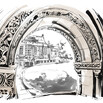Students Investigate Intersections of Art, Law, and Historical Memory
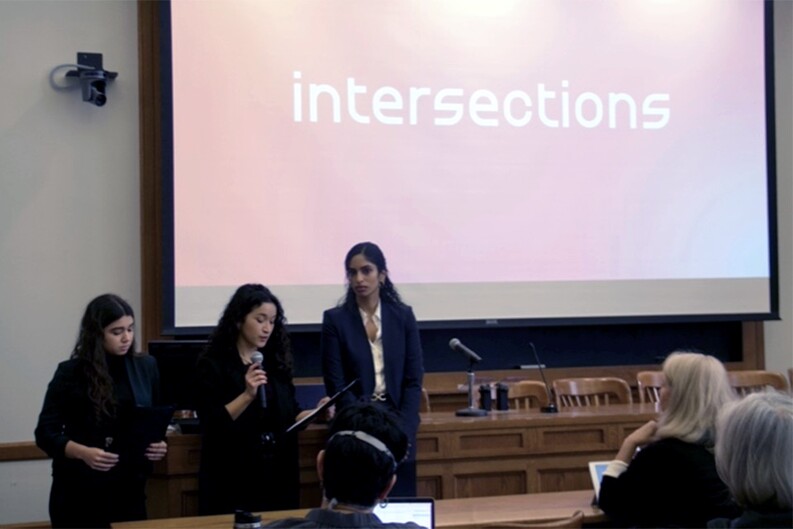
Yale Law School students Manoela Saldanha ’25, Debbie Rabinovich ’24, and Sreya Pinnamaneni ’24 entered the fall 2022 semester with three consuming questions: What is the role of art and aesthetics in social and legal movements? How can the interwoven language and tools of art and law be mobilized to rectify historic injustice? When can our skills be mobilized to support artists of many kinds in producing or protecting work?
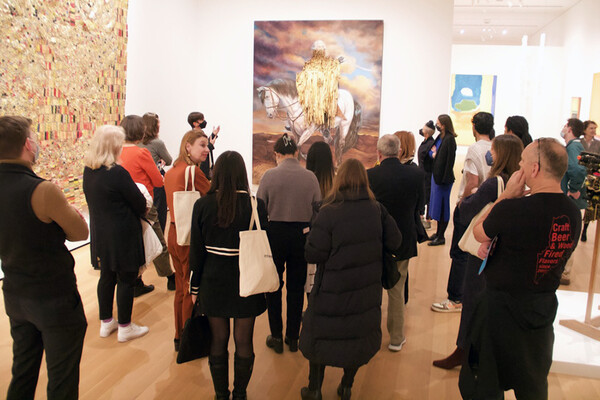
Around the globe, the three had just wrapped up multidisciplinary internships in the arts: Saldanha at Mar Filmes and Moovie Productions in Rio de Janeiro, Rabinovich at the War Childhood Museum in Bosnia, and Pinnamaneni at Musée du Louvre in Paris. These experiences sparked their curiosity about work at the intersection of art and law.
Saldanha, Rabinovich, and Pinnamaneni launched INTERSECTIONS, Yale Law School’s inaugural conference on art, justice, and the law with initial grant support from the Yale Law School Office of Student Affairs and the Oscar M. Ruebhausen Fund. A group of like-minded law students who shared a purposeful commitment to these intersections banded together, and the inaugural INTERSECTIONS Conference Committee — Amanda Pareja Villegas ’25, Gabriela Rico ’25, Marlene Arias ’24, Geneva Smith ’24, and Teddy Watler ’25 — was formed. The conference took place in spring 2023.
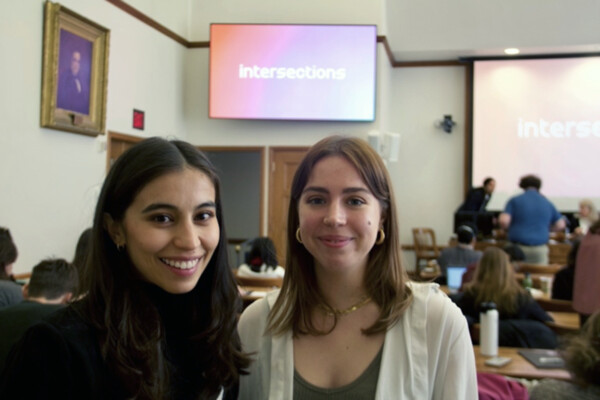
The committee envisioned INTERSECTIONS as an annual opportunity to foster critical discussion, imaginative scholarship, and cross-field collaboration around legal questions in the art and art-historical spheres.
WATCH: INTERSECTIONS conference video
“Building INTERSECTIONS was the highlight of 1L year,” Pareja said. “It was exciting to connect with art law professionals and delve into an area of law I had not heard of. It was also immensely rewarding to create a space to bring creative and curious people together to discuss the role of visual art as medium and mediator for justice. This experience confirmed the true possibility of charting one’s own path at Yale Law School.”
The conference theme, “Dialogues on Restitution, Memory, and Justice,” sought to build upon recent discourse among governments, art institutions, and human rights advocates concerning the dispossession, restitution, and memory of art and cultural artifacts.
“Laws around art have, in the past, been deployed in defense of empire and looting,” Rabinovich and Pinnamaneni wrote. “Yet the incredible artists, practitioners and academics before us today have laid the groundwork to grapple with the past and envision justice. INTERSECTIONS is an invitation for us all to imagine what roles art and the law can play in building the world to come.”
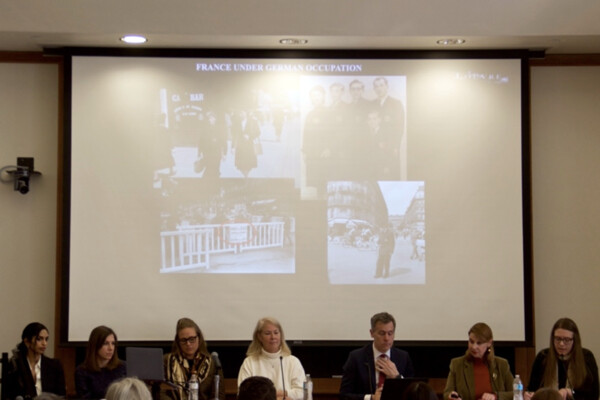
The first panel, “Modern Approaches to Restitution and Repatriation,” featured Emmanuelle Polack, the Louvre’s “art sleuth”; Laurel Zuckerman, named plaintiff in Zuckerman v. Metropolitan Museum of Art; Antonia Bartoli, Curator of Provenance Research at the Yale University Art Gallery; and Nicholas O’Donnell, Partner at Sullivan & Worcester and leading art law practitioner. The panel was co-moderated by Pinnamaneni and Katherine Wilson-Milne ’09, Partner at Schindler, Cohen & Hoffman.
The second panel, “Memory, Reparations, and Transitional Justice,” featured Amina Krvavac, Executive Director of the War Childhood Museum; Sarah Case, Deputy Program Director for the International Coalition of Sites of Conscience; traci kato-kiriyama, playwright and organizer of the National Nikkei Reparations Coalition; and Cécile Fromont, Professor in the History of Art at Yale University. The panel was moderated by Rabinovich.
The remainder of the conference was dedicated to connecting the themes of memory, justice, and repatriation to in-person art experiences. Three tailored tours of the Yale University Art Gallery — led by curators Lisa Brody, Antonia Bartoli, and Margaret Ewing — were specially designed for INTERSECTIONS. The gallery tours allowed participants to visit works with ongoing provenance disputes alongside pieces of contemporary art that deal directly with themes of justice and redress.
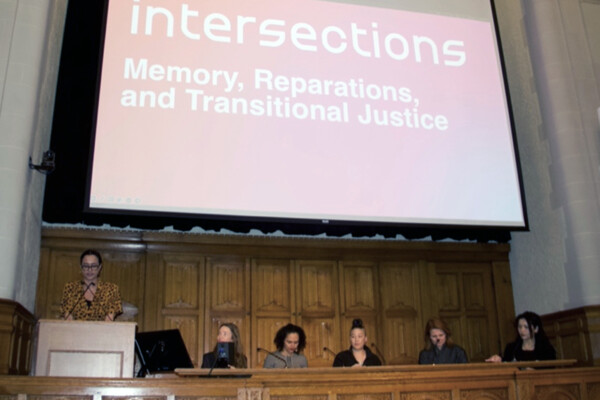
“INTERSECTIONS opened my eyes in particular to creative and cultural perspectives outside my experience,” O’Donnell said. “In my own work with Nazi-era claims, the role of dispossessed property in family history is of central importance. Hearing other histories was eye-opening.”
The entirely student-led conference concluded with a keynote address by Ana de Orbegoso, a New-York based Peruvian-American multidisciplinary artist whose practice explores aspects of gender and identity through the use of iconography and symbols from the collective memory. She is the creator of “So what do we do with our history?” (2015), which is exhibited in the permanent collection of the Art Institute of Chicago, and “Urban Virgins” (2006), which is has been continuously on tour since its inception. The series explore the contemporary resonances of iconic artworks from Peru’s cultural heritage: “huaco” Moche portrait vessels and Cusco School paintings, respectively.
De Orbegoso temporarily installed one of the neo-huacos from “So what do we do with our history?” in Yale School of Architecture’s Hastings Hall. The sculpture-projection was on view for the duration of the evening.
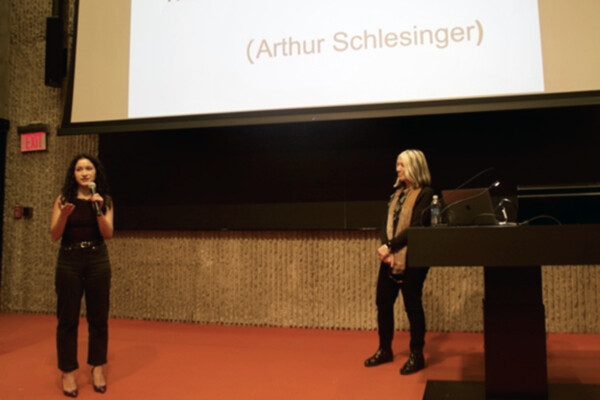
According to its organizers, INTERSECTIONS had a collective vision: to be a launch point for Yale Law School students who share a commitment to the progressive work at the intersection of art, law, and justice. The conference organizers note that the team is doing just that, as it prepares to steer the Yale Law School Art & Justice Collaborative in the 2023–2024 year. The team plans to produce the second INTERSECTIONS Conference, exploring new thematic frontiers, in spring 2024.

